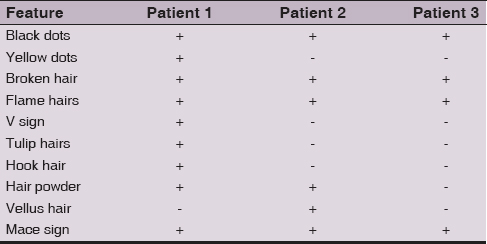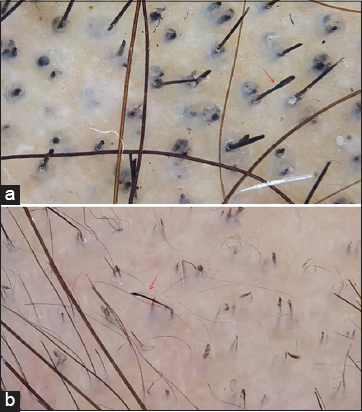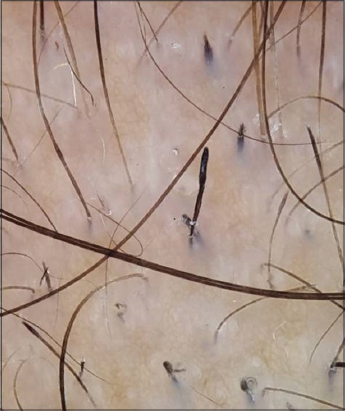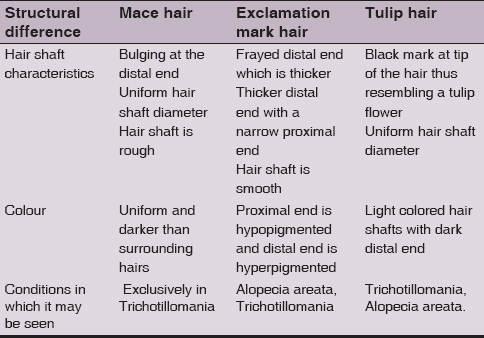|
Get Citation
|
|
|
Malakar S, Mukherjee SS. ‘Mace sign’- A defi nitive sign of trichotillomania?. Our Dermatol Online. 2017;8(4):491-492 |
|
|
Download citation file:
|
‘Mace sign’- A definitive sign of trichotillomania?
Subrata Malakar1, Samipa Samir Mukherjee2
1Department of Dermatology, Rita Skin Foundation, Kolkata, India; 2Department of Dermatology, Cutis Academy of Cutaneous Sciences, Bangalore, India
Corresponding author: Dr. Samipa Samir Mukherjee, E-mail: drsamipamukherjee@gmail.com
Submission: 20.01.2016; Acceptance: 06.04.2017
DOI: 10.7241/ourd.20174.139
Sir,
Patchy hair loss is a commonly encountered clinical scenario in day to day practice. Alopecia areata and trichotillomania are the commonest differential diagnosis to be considered. Trichotillomania is characterized as an obsessive compulsive hair pulling leading to the clinical manifestations of patchy hair loss affecting the vertex or parietal areas. This condition resembles alopecia areata (AA), since both disorders are initially non-scarring and may be patchy. Dermoscopy serves to be an important non invasive tool for differentiating between the two. Although multiple signs and features of both the entities have been described in literature till date a specific feature to distinguish between the two still remains elusive. We herein try to describe the ‘Mace’ sign which to the best of our knowledge is the most specific diagnostic feature of trichotillomania.
We had three different patients visiting our out patient department with history of patchy hair loss. The details of the patient profile has been given below (Table 1). All the three patients were diagnosed clinically as trichotillomania and dermoscopy was further done to substantiate the diagnosis.
Dermatoscopy is an useful non invasive tool that helps in diagnosis and also has the advantage of increasing patient compliance by actually demonstrating the nature of the problem to the care- givers, bystanders and the patient. Although multiple dermatoscopic features have been described for trichotillomania there is a significant overlap in the findings with other disorders like alopecia areata and tinea capitis to name a few. Fractured shafts are suggestive of trichotillomania, while the presence of exclamation mark hairs is indicative of AA [1]. Another study in 2014 documented the presence of irregularly broken, v-sign, flame hairs, hair powder and coiled hairs. Flame hairs, v-sign, tulip hairs, and hair powder were newly identified in this study [2].
Table 2 presenting Dermoscopic feature.
As it may be seen from the above table that mace sign is a consistent finding in all the three cases of trichotillomania. Although multiple dermatoscopic signs have been described in both the disorder the quest for the most specific sign continues which would clinch the diagnosis. We herein describe the ‘mace’ sign for broken terminal hairs which are uniform in diameter and pigmentation with a bulging distal end. The bulging distal end resembles the head of a mace and the longitudinal proximal end resembles the handle of the mace (Figs. 1a and 1b). The roughness of the shaft in Mace Sign also points towards manipulation of the hair by pulling and playing with it (Fig. 2).
These mace hairs structurally differ from the tulip hair and exclamation mark hair in the following (see table 3).
We propose that the mace hair sign may be a result of pulling, playing and manipulating the hair by the patient which leads to the structural deformities of the hair. The bulging distal end could occur due to splaying of the end leading to flattening giving the appearance of a bulge in 2 dimensional view.
We believe that this is the first time that this sign is being reported and further continuous observations need to be made regarding this type of hair to deem it as the most specific sign of trichotillomania.
REFERENCES
1. Abraham LS, Torres FN, Azulay-Abulafia L. Dermoscopic clues to distinguish trichotillomania from patchy alopecia areata. An Bras Dermatol. 2010;85:723–6.
2. Rakowska A, Slowinska M, Olszewska M, Rudnicka L. New trichoscopy findings in trichotillomania: flame hairs, V-sign, hook hairs, hair powder, tulip hairs. Acta Derm Venereol. 2014;94:303-6.





Comments are closed.